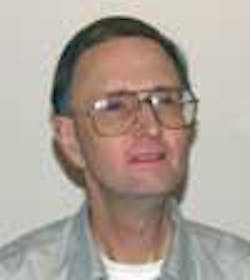Reliability and ease of implementation are critical for manufacturing
A discussion with Kevin Harding of the GE Global Research Center
VSD: What general needs do you see at GE for machine vision in manufacturing?
Harding: There are many opportunities in high-value manufacturing for machine vision, ranging from simple checks of assemblies to micron-level inspection for surface defects. Just as in the automotive industry, any complex assembly has the potential for human error. A wrong bolt, a missing washer, or a missing connector could lead to equipment failure. Machine vision is very good at these types of repetitive checks, where a person might easily miss a simple error. Surface inspection of everything from plastic sheeting to precision rotor assemblies can take a lot of time if done using only visual means. We will sometimes use a triple visual inspection to be certain of an assembly. Machine vision offers the potential for significant labor savings and less likelihood of missing the small defect.
VSD: Specifically, what do your shops look for in a vision system?
Harding: Because of the high value of many of our parts and the critical nature of verifying quality, one of the key parameters we look for in a vision system is reliability. GE works with a six-sigma philosophy, which means less than four defects per million. A bad blade in a turbine can mean failure, so we have to be right 100% of the time. An inspection system with regular down time, unreliable results, and maintenance issues has no place in our shops. Along with reliability, the shops need the type of quick support from the vendor to prevent down time in production. Shutting down a line, be it in plastics or turbines, can mean millions of dollars.
VSD: There are many types of vision systems today, ranging from inexpensive smart cameras to high-end automated gauging systems. What benefits and challenges do you see from implementing one end or another of this spectrum?
Kevin Harding is a senior researcher and technology leader in the area of optical metrology at the GE Global Research Center(Niskayuna, NY, USA: www.crd.ge.com.) He has been involved in the deisgn and development of unique optical systems and instrumentation for more than 25 years. He currently is a member of the board of directors of SPIE. Editor in chief Conrad Holton talked to him about end-user requirements for machine vision.
Harding: Inexpensive smart cameras are making practical many of the simple tasks that were hard to justify in the past. There is a great benefit in obtaining continuous process data for applications that in the past might have been checked only visually or using a go/no go gauge. Collecting more complete data allows the application of six -sigma tools to improve the process. Smart cameras play an important role in such digitization efforts. The biggest challenge in implementing the smart camera technology is often the educational part, understanding enough vision technology in the plants to use it properly. Smart cameras do what they do but have limitations, as well. We find that getting a good system integrator involved right up front to take care of the details such as lighting and packaging-so that we have a proper implementation quickly-is key to realizing the low-cost potential of such tools.
On the high end, gauging applications are critical in many of our processes. Costs associated with gauging of high-value parts are often in the millions of dollars, in one plant alone. Optical-based gauges can often offer better speed and less cost in such applications. But to be accepted for this use, they must undergo rigorous testing and qualification. Just dropping a system at our doorstep is not completing the job. The implementation job, including proving agreement with current practices, meeting gauge R&R [repeatability and reproducibility] requirements, and providing the data we need must all be complete before we can begin using the technology. I see too many systems that show pretty pictures, such as colorized 3-D images. We have no drawings that call out colors; we need numbers according to the part tolerances.
VSD: Do you see technology gaps in the capabilities of current vision systems?
Harding: The biggest gap I see in current vision technology is the application package. Coordinate-measurement-machine manufacturers have learned that you need to connect your measurements to the part drawings and to provide a way that a manufacturing engineer can program in a new part without learning some new proprietary language. Vision systems, and especially the new 3-D systems, do not provide that type of capability. Very few systems are oriented toward common manufacturing engineering practices in terms of setup or programming. Needing to send someone off for a training class is a big liability, not just for the small amount of training time, but because of the time to develop experience and the limited number of people who end up “knowledgeable” about how to use a particular system.
Two-dimensional vision has made some strides in this area with easier-to-use setup software, but the 3-D systems are a good 10 to 15 years behind the competing technologies in this area. The vision vendor will often just provide data points, which the user is then expected to figure out how to analyze, often using a second-source package. Some of these second-source packages are making progress, but they are still too specialized and often too expensive to be usable in the shop.
VSD: How do you approach a new application? Do you qualify, design, build, or RFP all imaging systems that you develop, install, or sell?
Harding: GE does not currently participate in the commercial vision market-we are an end user. But GE is an end user with sophisticated in-house resources we can use to address our needs. Our approach to an application depends on the complexity. Our first step is to evaluate the requirements of the application. Once the needs are understood, we assess whether the solution is available off-the-shelf-something that has been done successfully before multiple times-or something that is more of a stretch for the technology. If the problem has a commercial solution, we will then evaluate vendors to find the best fit, and work with that best vendor. If the solution requires development, we will evaluate what the value of that development would be to GE and the risks involved.
VSD: How do you interact with other manufacturers or integrators in the machine-vision community? What opportunities exist for interaction, and what additional changes or opportunities are needed?
Harding: We are not a commercial player in machine vision, so our interaction is as a customer. However, we also have significant in-house resources that we use to be sure we are taking the best path and making best use of technology. If needed, we can invest design and development resources to address a critical internal need. We are open to working with commercial suppliers to meet those needs where the situation fits. We look for suppliers who are willing to work with us, including building from our in-house technical analysis. We don’t want to pay extra for a vendor to reinvent a solution we already have available.
VSD: What could vision companies do to make your implementation job easier?
Harding: There are a number of things vision companies could do to make implementation easier for end users like GE. The first thing we need vision vendors to do is to listen. It is important that any solution we implement be compatible with our current plant practices. Understanding those practices is necessary to a successful solution. We don’t expect the vendor to become an expert in our practices, just respect them. The next thing we need is a clear understanding of the vendor’s capabilities. We recognize that a small vendor may not have the resources to cover all technologies and don’t expect them to do so. But we need to understand what capabilities and limitations the vendor has to offer. We are willing to help fill in the gaps, but we need an honest assessment of the vendor’s capabilities.
Finally, we need open communications when the system is being built. We don’t want to find out at the last minute something is not working right. This can be a problem to production needs, as well as to the reputation of the technology in that particular shop. We are not like a small company who may not have anyone to work with the vendor. We have significant resources that can be employed to help the vendor succeed, but we need to know what is needed.
VSD: Are there any particular technologies or capabilities that you would like to see in the future?
Harding: I would like to see more systems made as complete solutions. This has been done in some areas such as electronics, but not for durable goods to any large extent. There are quite a few applications that vary little from one manufacturer to another. Ready-to-use packages could allow fast, low-risk implementation of some good applications that would help introduce machine vision into areas where we are not using it now.
The other area I would like to see grow in the future would be 3-D vision systems with good applications packages. Just like 2-D systems that will do simple fittings to geometry, why not have a 3-D system that will do a simple best-fit sphere, cylinder, plane, or angle? There is a great deal that could be done with those simple tools without exporting data to high-end packages with more capabilities than we need to do the simple stuff.
Three dimensions should not mean complicated engineering applications only. The 3-D industry has focused on reverse engineering of parts, but our big application area is in manufacturing parts we know well. Machine vision has accomplished a lot just being able to find the size of a hole, separation of edges, or size of a blob. So why not provide the equivalent with a 3-D measurement system?

